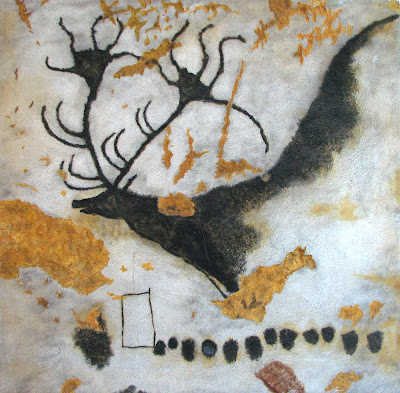History runs in fits and starts. So does your artistic development.
 |
| Breaking Storm, Carol L. Douglas |
“Scotch and soda, jigger of gin…” crooned my husband early one morning as we trekked over Beech Hill. That’s a Kingston Trio song from 1958. It set Doug to musing that music changed a lot more in the three decades from 1960 to 1990 than it did from 1990 to the present.
That’s how history works. It’s linear, but it runs in fits and starts. There are long periods of stasis and then periods of rapid change.
The decade I was born in gave us portable coolers, the polio vaccine and birth control pills. It also gave us the integrated circuit. That, of course, changed the world.
In recent decades we’ve been coasting, building incrementally on the gains of the Computer Age. Then, bam! COVID. Change often comes as a complete surprise. It’s also often messy, difficult and painful.
 |
| Coast Guard Inspection, Carol L. Douglas |
The years 1346–51 brought the Black Death to Europe. That in turn brought the end of centuries under the feudal system. Similarly, the Chinese Cultural Revolution was a decade of brutal paroxysm that finally obliterated the rigid feudal system of old China. As bitter and awful as the two 20thcentury world wars were, they ushered in modern society. Few of the unwitting participants in these cataclysms enjoyed them, but all of us who follow have benefitted.
That’s true of artistic change as well. It can be, frankly, disheartening. We’re potting along painting in the usual way, feeling like we’re turning out good work, and suddenly something shifts. Everything we paint seems horrible to us.
 |
| Wreck of the SS Ethie, Carol L. Douglas |
This is an inevitable rest-stop along any creative journey. It’s important, because it signifies growth. You have three possible paths out:
- Scuttle back to what you were doing before;
- Quit and do something else for a while;
- Find ways to quiet that awful voice in your head.
Obviously, I recommend the third path, but the other two are very common (and self-limiting) reactions. How can you avoid them?
Remind yourself of a basic fact: you haven’t suddenly forgotten how to paint. Dissonance is part of growth. Even experiments that fail are valuable; they’re an essential part of the painting process.
Stop wiping out the canvases you don’t like. Sometimes a painting is uncomfortable to look at because it’s pointing the way forward. It can seem like an awkward outlier when you do it. Five years later, you realize it was a bellwether and the best thing you painted that year. You’ll blunt your development if you wipe out everything that makes you uncomfortable.
Don’t seek validation through your friends’ opinions. They’re unlikely to see the potential in an ungainly effort. In fact, group-norming of any kind can be deadly to change. This is no time to be assessing whether something is ‘good’ or ‘bad’—it’s time to simply produce a lot of work.
 |
| Beautiful Dream, Carol L. Douglas |
Discomfort with change can sometimes result in paralysis. If that’s you, try falling back on strict exercises that force you to stop thinking about results and start thinking about process. That’s where “painting a day” exercises are invaluable. If you don’t feel like joining a formal one, make one up for yourself.



























